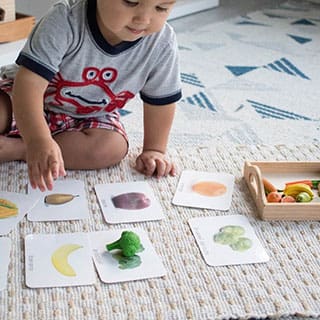PREFER TO LISTEN & FOLLOW ALONG?
Because the name Montessori was never copyrighted, there is a wide range of so-called Montessori schools in Chennai using the term wrongfully in ignorance or malice to further their personal interests. It can be difficult to know which are genuinely applying the principles and theories of Dr. Maria Montessori.
When considering a place, ask for a tour of the environment or even better, an hour’s observation of the classroom during a work cycle. Here are 10 things to look for when searching for the best Montessori school for your child –
1. Hands-on, concrete learning
The school promotes a hands-on understanding of the world with tangible materials. The children make discoveries for themselves through touching, exploring, and working with beautiful, solid materials.
The hand takes in information in a concrete way to pass on to the brain. It’s one thing to hear or watch something, but we learn on a deeper level when we integrate our listening or watching with using our hands. We move from passively learning to actively learning.
The materials in a Montessori classroom are so beautifully prepared and attractive that the child is drawn to them to make discoveries for themselves, with their hands.
An example of hands-on learning is the math materials found in a Montessori classroom for 3-to-6-year-olds. A small golden bead represents 1. A string of 10 beads represents 10. A mat of 10 rows of 10 beads represents 100. A stack of 10 mats represents 1,000.

2. Child-sized furniture
The materials are set out on shelves at the children’s level. The activities are beautiful, and attractively presented on trays or in baskets, with no missing parts. The learning materials are displayed on open shelves, easily accessible to the children. Classrooms also include low sinks accessible to the children, child-sized furniture, cozy spaces for quiet reading, reachable shelves with work available for free choice, and child-sized kitchen utensils so the students can eat, prepare, and clean up their snack on their own.
3. Mixed age groups
3-to-6-year-olds, 6-to-9-year-olds, and 9-to-12-year-olds. The older children can model for, and help, the younger children. During the first 2 years in a 3-6 classroom, children look forward to their turn to be a leader. In their third year, children get their turn and take pride in being the oldest. They serve as role models for younger students; they demonstrate leadership and citizenship skills. They reinforce and consolidate their own learning by teaching their peers concepts they have already mastered. In their senior years, they express confidence, develop self-esteem and self-sufficiency, and show responsibility.
4. Internationally-certified teachers
The main teacher has to have completed an internationally recognized Montessori training program. We particularly recommend the Association Montessori Internationale, because this is the training organization Dr. Montessori’s family set up to maintain the integrity of their courses.
5. Respectful environment
The teacher talks respectfully to the children as a guide, encouraging them to be resourceful about finding answers to their questions: “I don’t know. Let’s find out!”
6. Child-led learning
Child-led learning is emphasized over traditional learning. Rather than the teacher standing at the front of the class telling the children what they need to know, the children are free to explore and make discoveries for themselves in a natural way.
7. Unstructured work time
The children are free to choose what they work on and free to work uninterrupted for (ideally) three-hour periods. Unstructured work time allows children the freedom to explore, create and discover without predetermined rules or guidelines. It’s been shown to foster cognitive development while boosting physical development and social and emotional development. It specifically helps creativity and imagination, problem-solving abilities and social skills.
8. Happy & independent children
You will find that children in a Montessori classroom are generally happy and working independently on materials in a place of their choosing. The children’s natural drive towards independence is fostered through practical, social, and intellectual experiences. The child becomes an active agent in her own education, saying, “Help me to do it myself”. We honor this by helping children move to increasingly higher levels of independence and self-reliance.
9. No testing
There is little or no testing. The teacher knows which activities each child has mastered, so there is little need to test a child.
10. Holistic development approach
The school treats each child as a unique individual while looking at all aspects of their development — social, emotional, physical, cognitive, and linguistic.
☙
Are you looking for an emotionally-safe Montessori school for your child? Book a free consultation today to understand their developmental needs and how we can help them unlock their true potential.






